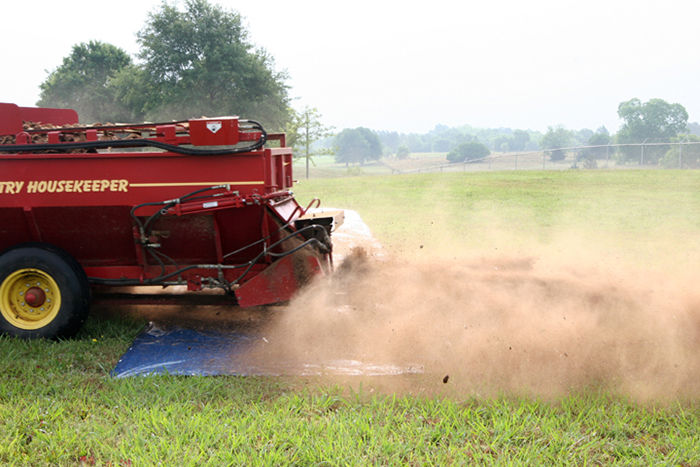
Proper nutrient management is a vital part of all agricultural enterprises, especially for those using any form of manure nutrients. Better understanding of the threats to our water, soil, and environment, and improved nutrient management practices and techniques have enhanced our ability to develop nutrient management plans that enable producers to maximize use of manure nutrients and minimize potential risks to the environment.
Cost of commercial fertilizers continues to increase, making use of animal manures an important economic decision for many producers. However, proper use of nutrients from animal manures is also important from the standpoint of preserving our water, soil, and environment. Application of nutrients beyond crop needs not only increases the potential for nutrient loss from fields, it is also a waste of valuable fertilizer nutrients that could be used on another field on the farm or sold to generate revenue. Calibrating litter spreaders (knowing the rate of litter application under specific conditions) is important to ensure proper nutrient management and maximize the economic potential of manure nutrients.
Manure and litter spreaders are typically calibrated using the same techniques designed for calibrating commercial fertilizer spreaders. Precision calibration for commercial fertilizer spreaders is critical for obvious reasons. However, calibrating litter and manure spreaders can be difficult because of differences in material density, handling and flow characteristics, and particle size, especially when spreading cake-out litter that may have larger chunks and increased moisture compared to total-cleanout litter.
One of the most widely used and recommended methods of litter spreader calibration is referred to as the “tarp method.” The procedure outlined below is a modified version of the tarp method that works well for poultry litter spreader calibration. One person can easily perform spreader calibration in only a few minutes.
Materials Needed
- six small tarps all the same size (such as 8’ by 10’)
- 5-gallon bucket or other weighing container
- scale
- calculator



Step 3. Assess the spread pattern of litter over the tarps. Estimate the width of the area of heaviest application and the width of lesser application on the edges of the spread pattern. Use this information to estimate the distance needed between spreader passes to get a uniform application over all the tarps. On future passes, overlap the thin edges of the spread pattern, but do not overlap the areas of heaviest application.
There are drastically different spread patterns and rates of application between various types of litter and litter application equipment. For example, cake-out litter spread with a decaking machine yields a completely different pattern and application rate than litter from a total house cleanout spread with a spreader truck. Calibrate with the specific equipment and the particular type litter you will actually be working with.


Step 4. Make a pass on each side of the first pass at the appropriate distance estimated in Step 3. If you have estimated the distance correctly, you should get an even application of litter across all areas between the centerline of the second and third pass.


Step 7. Calculate the rate of application for each of the four middle tarps. Use this equation (taken from the Poultry Waste Management Handbook):
(pounds of litter on tarp) x 21.78 ÷ area of the tarp (square feet) = tons of litter/acre
For example, 8 pounds of litter multiplied by 21.78 and divided by 80 (our tarps in this example were 8 feet by 10 feet) equals an application rate of 2.18 tons of litter per acre (21.78 is a constant previously determined).
Step 8. Repeat the procedure several times to get a reliable average. If the rate of application is higher or lower than the desired rate based on nutrient management planning, then make equipment adjustments (RPMs, flow controls, gate opening level) and/or drive the equipment faster or slower.
This procedure is relatively inexpensive. An 8-by-10-foot tarp currently retails for $7 to $15, depending on the quality. Any reliable scale you may have will work, or you can purchase a dial scale similar to the one in the example for less than $50. Most people have plastic buckets on the farm, and most have a simple calculator or have a calculator feature on their cell phone. In addition, materials can be used over and over for future calibrations should equipment, litter type, or desired rate of application change.
Reference
Collins, E. R., J. C. Baker, L. E. Carr, H. L. Brodie, and J. H. Martin, Jr. 1999. Chapter 7: Application Equipment. In Poultry Waste Management Handbook. Natural Resource, Agriculture, and Engineering Service (NRAES), Ithaca, New York.
Publication 2495 (POD-07-18)
Revised by Tom Tabler, PhD, Extension Professor, Poultry Science, from a previous edition by Craig D. Coufal, former Assistant Extension Professor, Poultry Science, and Herb Willcutt, former Extension Professor, Agricultural and Biological Engineering.







